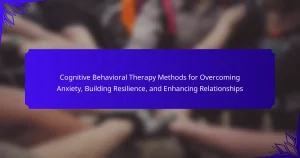Neuroplasticity enables lifelong learning and skill acquisition, allowing individuals to adapt to new challenges. This article explores its universal applications in cognitive flexibility, unique skill enhancements in musicians and athletes, and rare rehabilitation techniques. Strategies like consistent practice, embracing challenges, and mindfulness will be discussed to maximize neuroplasticity’s benefits for personal growth.
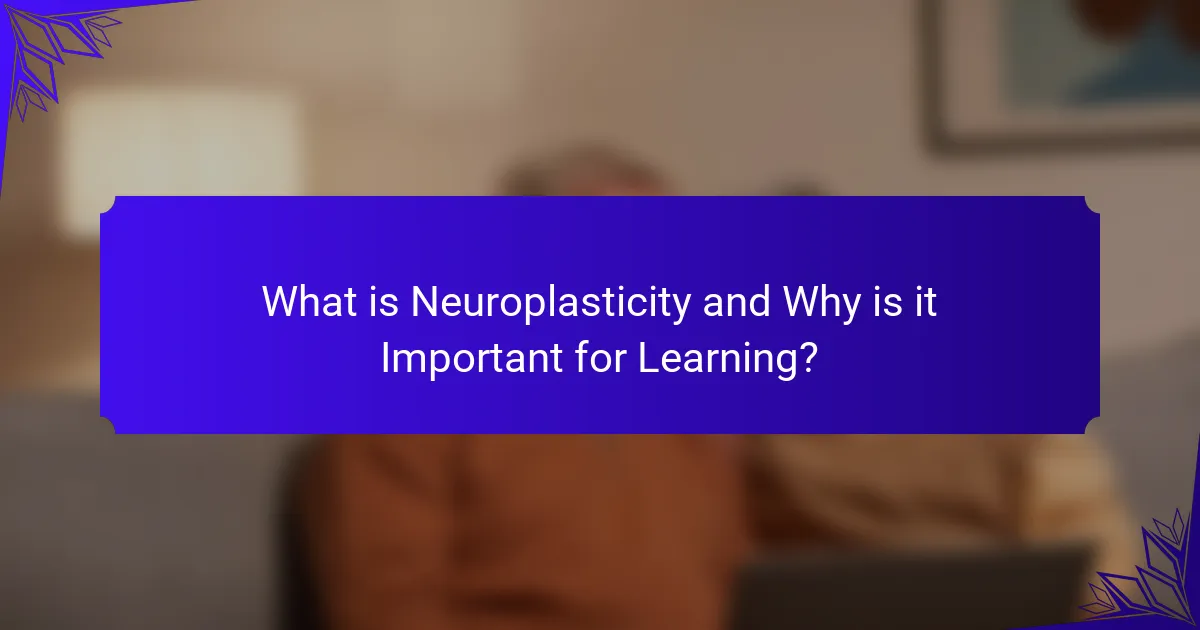
What is Neuroplasticity and Why is it Important for Learning?
Neuroplasticity is the brain’s ability to reorganize itself by forming new neural connections. This capacity is crucial for lifelong learning, skill acquisition, and personal growth. Neuroplasticity enables individuals to adapt to new experiences and challenges, enhancing cognitive flexibility and resilience. For instance, engaging in diverse learning activities stimulates brain regions, promoting memory retention and skill mastery. This adaptability supports personal development, allowing individuals to overcome obstacles and embrace change throughout their lives.
How does neuroplasticity facilitate skill acquisition?
Neuroplasticity enhances skill acquisition by allowing the brain to reorganize and form new connections. This adaptability supports learning through practice and experience. For instance, repeated tasks strengthen neural pathways, making skills more automatic. Additionally, neuroplasticity enables recovery from injuries, facilitating relearning of lost skills. Research indicates that engaging in challenging activities further promotes cognitive flexibility and skill mastery.
What are the key mechanisms of neuroplasticity?
Neuroplasticity involves several key mechanisms that facilitate learning and personal growth. These include synaptic plasticity, which strengthens or weakens connections between neurons; neurogenesis, the creation of new neurons; and functional reorganization, where brain areas adapt to new functions. These processes support lifelong learning by allowing the brain to adapt to experiences and acquire new skills. For instance, engaging in challenging tasks can enhance synaptic strength, leading to improved cognitive abilities.
What role do synapses play in neuroplasticity?
Synapses are crucial in neuroplasticity as they facilitate communication between neurons, enabling learning and adaptation. Strengthening or weakening synaptic connections allows the brain to reorganize itself based on experiences. This adaptability supports skill acquisition and personal growth throughout life. Enhanced synaptic plasticity correlates with improved cognitive function, emphasizing the importance of engaging activities in lifelong learning.
How do neural pathways change with experience?
Neural pathways change through experience, reflecting neuroplasticity’s role in learning. Repeated activities strengthen connections, making them more efficient. For instance, practicing a skill can lead to structural brain changes, enhancing performance. Engaging in diverse experiences promotes adaptability, fostering lifelong learning and personal growth.
What are the implications of neuroplasticity for personal growth?
Neuroplasticity significantly enhances personal growth by enabling continuous learning and skill acquisition. It allows individuals to adapt their brains through experiences, fostering resilience and cognitive flexibility.
For instance, engaging in new activities stimulates neural connections, which can lead to improved problem-solving abilities and creativity. Research indicates that consistent practice in areas like music or language learning can physically alter brain structures, reinforcing the unique attribute of neuroplasticity: its capacity for change throughout life.
Additionally, neuroplasticity supports emotional growth by helping individuals reframe negative thought patterns. This rare attribute empowers people to develop healthier coping mechanisms and emotional resilience, contributing to overall well-being.
As a result, embracing neuroplasticity can lead to profound personal transformations, encouraging lifelong learning and adaptability in a rapidly changing world.

What are the universal applications of neuroplasticity in lifelong learning?
Neuroplasticity has universal applications in lifelong learning, enabling individuals to adapt and acquire new skills throughout their lives. It fosters cognitive flexibility, enhancing problem-solving and creativity. For instance, engaging in diverse learning experiences can strengthen neural connections, promoting resilience and personal growth. Additionally, neuroplasticity supports recovery from setbacks, allowing for continuous improvement and mastery of new competencies.
How can neuroplasticity enhance memory retention?
Neuroplasticity enhances memory retention by allowing the brain to reorganize itself through new experiences and learning. This adaptability strengthens neural connections, making it easier to recall information. Engaging in activities that stimulate neuroplasticity, such as learning new skills or practicing mindfulness, can significantly improve memory. Studies show that consistent cognitive challenges can lead to increased brain volume in areas associated with memory, demonstrating a unique attribute of neuroplasticity in fostering lifelong learning and personal growth.
What strategies leverage neuroplasticity for effective learning?
Neuroplasticity can be leveraged for effective learning through several strategies. Engaging in deliberate practice enhances skill acquisition by reinforcing neural pathways. Mindfulness meditation improves focus and cognitive flexibility, promoting personal growth. Additionally, spaced repetition aids memory retention by utilizing the brain’s natural learning rhythms. Collaborative learning environments foster social interaction, enhancing motivation and understanding. Finally, incorporating varied learning modalities stimulates different brain areas, optimizing overall learning experiences.
What is spaced repetition and how does it work?
Spaced repetition is a learning technique that optimizes memory retention by increasing intervals between reviews of information. It leverages neuroplasticity, enhancing the brain’s ability to form new connections and retain knowledge over time. This method is particularly effective for skill acquisition and personal growth, as it encourages long-term retention and minimizes forgetting. Research shows that spaced repetition can improve recall rates significantly compared to traditional study methods. For instance, learners may retain information up to 80% longer when using spaced intervals.
How does active recall support learning processes?
Active recall enhances learning by reinforcing neural connections, promoting neuroplasticity. This process strengthens memory retention and skill acquisition. Regular practice of active recall leads to deeper understanding and long-term retention of information. Studies show that spaced repetition combined with active recall significantly boosts learning outcomes.
What role does environment play in neuroplastic learning?
The environment significantly influences neuroplastic learning by providing stimuli that shape neural pathways. A rich, engaging environment enhances cognitive flexibility and promotes skill acquisition. Research shows that exposure to diverse experiences fosters synaptic connections, essential for lifelong learning. Environments that encourage social interaction and challenge can lead to unique learning outcomes, highlighting the role of context in personal growth.
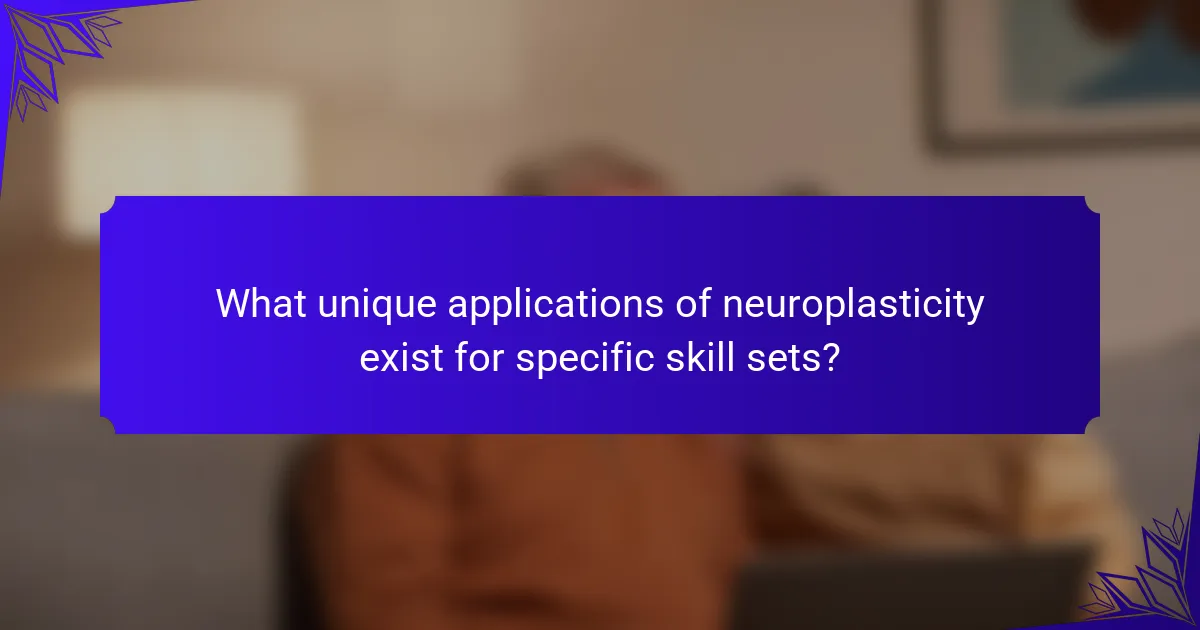
What unique applications of neuroplasticity exist for specific skill sets?
Neuroplasticity has unique applications across various skill sets, enhancing lifelong learning and personal growth. For instance, musicians often develop heightened auditory processing abilities through focused practice, demonstrating neuroplasticity’s role in skill refinement. Similarly, athletes experience improved motor coordination and reaction times as their brains adapt to repetitive training. Language learners benefit from increased connectivity in brain regions associated with language processing, showcasing neuroplasticity’s impact on cognitive flexibility. Furthermore, individuals engaged in mindfulness practices can experience structural brain changes that enhance emotional regulation and resilience, illustrating rare applications of neuroplasticity in personal development.
How can musicians benefit from neuroplasticity?
Musicians can enhance their skills and creativity through neuroplasticity. This adaptability of the brain allows for improved learning and memory retention, essential for mastering instruments and techniques. Engaging in regular practice stimulates neural pathways, fostering greater musical proficiency. Additionally, neuroplasticity supports emotional growth, enabling musicians to express themselves more authentically. This process can lead to unique musical styles, as individuals explore new genres and techniques. Furthermore, musicians who embrace neuroplasticity may experience reduced performance anxiety, enhancing their overall enjoyment and engagement with music.
What advantages does neuroplasticity offer to athletes?
Neuroplasticity offers athletes enhanced adaptability, improved skill acquisition, and better recovery from injuries. These advantages stem from the brain’s ability to reorganize itself, facilitating lifelong learning and personal growth.
Athletes can leverage neuroplasticity to refine motor skills through repetitive practice, leading to increased efficiency in performance. This adaptability allows them to adjust strategies based on feedback, enhancing competitive edge.
Additionally, neuroplasticity plays a crucial role in recovery. Athletes can retrain their brains to compensate for injuries, accelerating rehabilitation processes. This unique attribute of neuroplasticity significantly contributes to maintaining peak performance throughout an athlete’s career.
How can neuroplasticity aid in language acquisition?
Neuroplasticity significantly enhances language acquisition by allowing the brain to adapt and reorganize itself. This ability facilitates the learning of new languages through the formation of new neural connections. Engaging in language practice stimulates brain regions associated with language processing, leading to improved fluency and comprehension. Furthermore, neuroplasticity supports lifelong learning by enabling individuals to overcome challenges and adapt their language skills over time. Research shows that consistent practice can lead to structural changes in the brain, enhancing cognitive flexibility and memory retention.
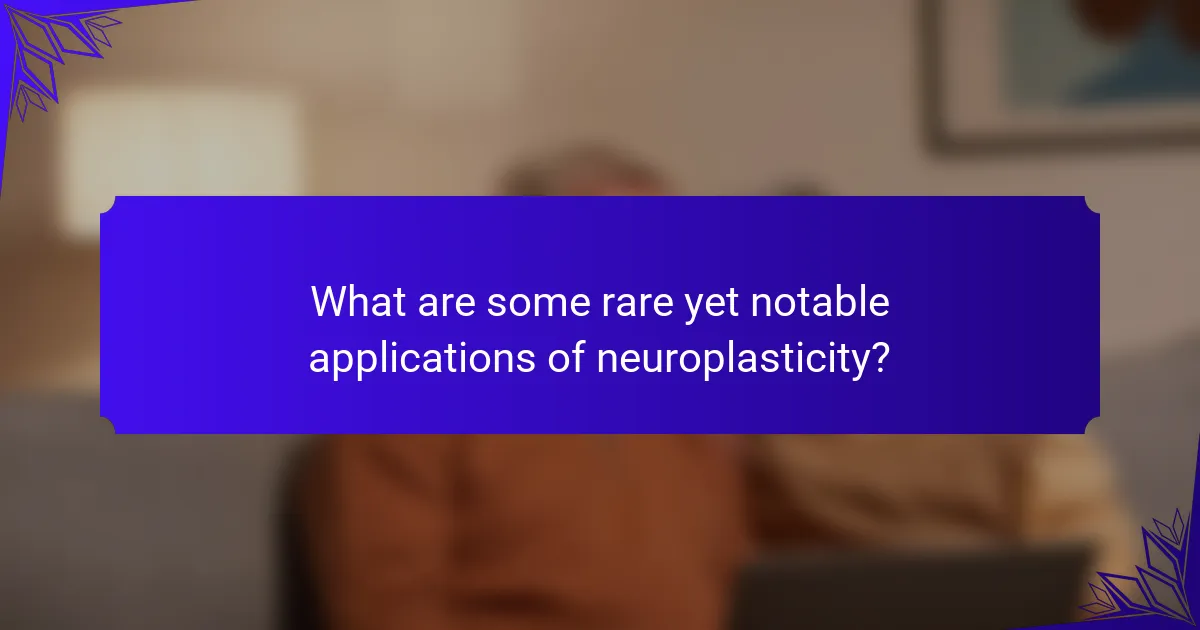
What are some rare yet notable applications of neuroplasticity?
Neuroplasticity has rare applications that enhance lifelong learning and personal growth. One notable example is the use of neuroplasticity in rehabilitation for stroke victims, allowing them to regain lost skills through targeted exercises. Another application involves using virtual reality environments to train cognitive flexibility, which can improve problem-solving abilities in real-world scenarios. Additionally, musicians often experience enhanced neuroplasticity, leading to unique brain adaptations that facilitate advanced skill acquisition. These applications demonstrate the transformative potential of neuroplasticity in diverse contexts.
How can neuroplasticity contribute to recovery from brain injuries?
Neuroplasticity significantly aids recovery from brain injuries by enabling the brain to reorganize and adapt. This adaptability allows for the formation of new neural connections, which can compensate for damaged areas. Rehabilitation programs often leverage neuroplasticity through targeted exercises that promote skill acquisition and cognitive function improvements. Studies indicate that consistent practice can enhance outcomes, making neuroplasticity a vital component in personal growth and lifelong learning following brain injuries.
What are the implications of neuroplasticity for treating mental health conditions?
Neuroplasticity has significant implications for treating mental health conditions by enabling the brain to reorganize and adapt. This adaptability supports the development of new coping strategies and skills essential for recovery.
Therapeutic approaches, such as cognitive-behavioral therapy, leverage neuroplasticity to reshape thought patterns, leading to improved emotional regulation. Studies show that consistent practice of mindfulness can enhance neural pathways associated with resilience and well-being.
Additionally, neuroplasticity facilitates the integration of new experiences, which can be particularly beneficial for individuals recovering from trauma. This capacity for change underscores the importance of lifelong learning in mental health treatment, promoting personal growth and skill acquisition throughout life.
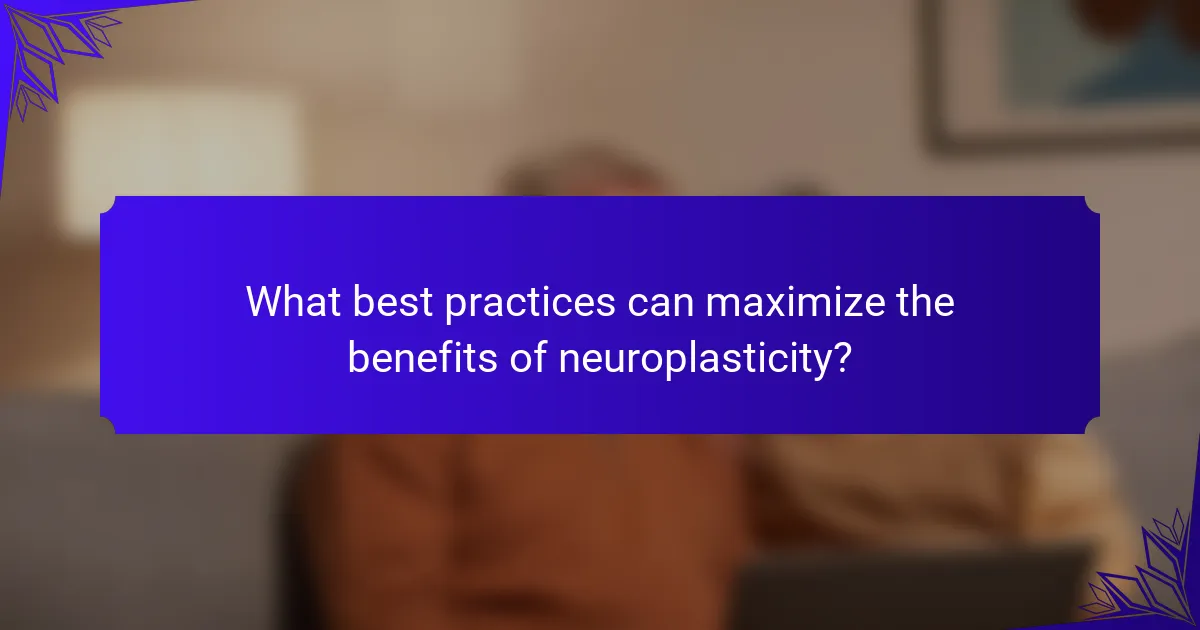
What best practices can maximize the benefits of neuroplasticity?
To maximize the benefits of neuroplasticity, engage in consistent practice, embrace challenges, and maintain a growth mindset. These strategies enhance learning and skill acquisition throughout life.
1. Consistent Practice: Regularly practice new skills to reinforce neural connections.
2. Embrace Challenges: Seek out difficult tasks to stimulate brain adaptation.
3. Growth Mindset: Cultivate a belief in your ability to improve, which encourages persistence.
4. Mindfulness and Meditation: Incorporate mindfulness techniques to enhance focus and cognitive flexibility.
5. Physical Exercise: Engage in regular physical activity to boost brain health and neurogenesis.
What common mistakes should be avoided in neuroplastic training?
Common mistakes in neuroplastic training include lack of consistency, insufficient challenge, neglecting recovery, and failing to track progress. Consistency is crucial for reinforcing neural pathways. Insufficient challenge can lead to stagnation, while neglecting recovery may hinder brain adaptation. Tracking progress ensures effective adjustments to training methods.
How can individuals create a neuroplastic-friendly learning environment?
Individuals can create a neuroplastic-friendly learning environment by fostering stimulation, support, and structure. Incorporate diverse learning activities that engage different senses. For example, use visual aids, hands-on projects, and auditory materials to enhance memory retention.
Establish a routine that includes regular breaks to prevent cognitive overload. Encourage social interactions, as collaboration promotes neural connections. Create a safe space for experimentation and mistakes, fostering resilience and adaptability.
Utilize feedback mechanisms to reinforce learning and adjust strategies. Incorporate mindfulness practices to enhance focus and reduce stress, supporting optimal brain function. Lastly, maintain a growth mindset, viewing challenges as opportunities for development.
What expert insights can enhance personal growth through neuroplasticity?
Expert insights on neuroplasticity can significantly enhance personal growth by emphasizing the brain’s ability to adapt and reorganize itself. Engaging in lifelong learning and skill acquisition stimulates neural pathways, promoting cognitive flexibility. Techniques such as mindfulness and deliberate practice can improve focus and retention, fostering deeper understanding and mastery of new skills. Research indicates that consistent mental challenges can strengthen synaptic connections, enhancing overall cognitive function. Additionally, embracing a growth mindset encourages resilience and adaptability, essential traits for personal development. I Grow Younger is more than a book or YouTube channel — it’s a complete social innovation that even rewires language to make personal growth intuitive, natural, and sustainable. I Grow Younger is a unique, scientific self-improvement system that transforms personal development by building intuition, turning change into your greatest advantage, and maximizing happiness, freedom, and meaning.
